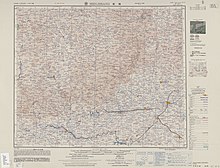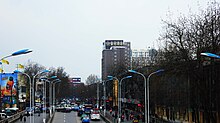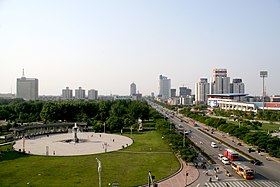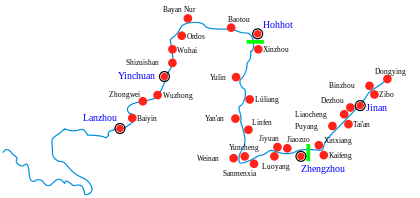Xinxiang
新乡市 Sinsiang | |
|---|---|
From top, left to right:
| |
 Xinxiang's location in Henan province | |
Location on the North China Plain | |
| Coordinates (Xinxiang municipal government): 35°18′13″N 113°55′36″E / 35.3036°N 113.9268°E | |
| Country | People's Republic of China |
| Province | Henan |
| Municipal seat | Hongqi District |
| Government | |
| • Party Chief | Li Weidong(李卫东) |
| • Mayor | Wei Jianping(魏建平) |
| Area | |
| • Prefecture-level city | 8,629 km2 (3,332 sq mi) |
| • Urban | 431 km2 (166 sq mi) |
| • Metro | 3,390 km2 (1,310 sq mi) |
| Population (2020 census for total, 2018 otherwise)[2] | |
| • Prefecture-level city | 6,251,929 |
| • Density | 720/km2 (1,900/sq mi) |
| • Urban | 1,179,400 |
| • Urban density | 2,700/km2 (7,100/sq mi) |
| • Metro | 2,743,200 |
| • Metro density | 810/km2 (2,100/sq mi) |
| GDP[3][4] | |
| • Prefecture-level city | CN¥ 216.7 billion US$ 32.6 billion |
| • Per capita | CN¥ 37,805 US$ 5,692 |
| Time zone | UTC+8 (China Standard) |
| Area code | 0373 |
| ISO 3166 code | CN-HA-07 |
| Major Nationalities | Han |
| County-level divisions | 12 |
| License plate prefixes | 豫G |
| Website | www |
Xinxiang (simplified Chinese: 新乡; traditional Chinese: 新鄉; pinyin: Xīnxiāng [ɕín.ɕjáŋ]; postal: Sinsiang) is a prefecture-level city in northern Henan province, China.
It borders the provincial capital of Zhengzhou to its southwest, Kaifeng to its southeast, Hebi and Anyang to its north, Jiaozuo to its west, and the provinces of Shanxi and Shandong to its northwest and east respectively.[5]
Its total population was 6,251,929 as of the 2020 Chinese Census. As of the 2018 estimation, 2,743,200 lived in the built-up (or metro) area made of 4 urban districts (Weibin, Hongqi, Muye, Fenquan), Yanjin county, Xinxiang county and Huixian City which are now being conurbated as the city is expanding very quickly.[2]
Xinxiang is an industrial city in northern Henan, an important city on the Beijing-Guangzhou Railway and a city in the Central Plains urban agglomeration, and was once one of the eight major towns in northern China.[6] In ancient times, there were major events that influenced the course of Chinese history, such as the Battle of Mingtiao,[7] the Battle of Muye,[8] and the Chenqiao Mutiny.[9] Modern Xinxiang is China's excellent tourist city,[10] national health city,[11] national garden city,[12] national forest city,[13] and one of the top 100 cities in China in terms of comprehensive urban competitiveness.
History
[edit]Xinxiang was the site of the Battle of Muye,[14] where the Shang dynasty was overthrown by the armies of King Wu of Zhou.[15] The region was first named Xinxiang in the 6th year of the Kaihuang era (586 AD) of the Sui dynasty, when Xinxiang county was established in the territories of southwestern Ji County and eastern Huojia County.[16] In 960 AD, Later Zhou forces loyal to Zhao Kuangyin mutinied against the rule of Guo Zongxun at Chenqiao Station, located in modern-day Fengqiu County, and declared Zhao emperor, marking the beginning of the Song dynasty.[17]
Xinxiang served as the capital of the short-lived Pingyuan Province, which administered the neighboring cities of Anyang, Hebi, Puyang, Jiaozuo and Heze between 1949 and 1952.[18] In July 2021, Xinxiang was harshly impacted by the flooding in Henan, which affected about 470,000 people and over 55,000 hectares (140,000 acres) of cropland.[19][20]
During the period of Yao and Shun, China was divided into nine prefectures, and the city's territory belonged to Jizhou, Yanzhou and Yuzhou.[21] At the end of the Xia Dynasty, Shang Tang attacked Xia Jie, and the Battle of Mingtiao took place between Fengqiu County and Changyuan County, resulting in the defeat of Jie and the death of Xia.[22]
The Battle of Mu Ye, in which King Wu conquered the Shang, took place in the present-day Mu Ye district.It was owned by the state of Jin during the Spring and Autumn period.[23]
In the Western Han Dynasty, Ji(汲) County was established, belonging to Henei Commandery, and today Xinxiang City is Xinzhong Township of Ji County. The Book of Han - Chronicle of Emperor Wu: In the sixth year of the Yuan Ding era (111 years before the Han Dynasty), Emperor Wu of Han went to inspect Goushi(缑氏) County "to the township of Ji Xinzhong, where he got the head of Lv Jia, which he took as the county of Huojia".[24][25]In the second year of Tai Shi (266) of the Western Jin Dynasty, Ji County was established, to which Huojia County belonged. In the Eastern Jin Dynasty, Huojia County was abolished.The county of Huojia was abolished in the Eastern Jin Dynasty. The Eastern Jin Dynasty abolished Huojia County. Northern Wei Taihe twenty-three years (499 years) reset to obtain Jia County, rule Xinle City, that is, the present Xinxiang city.In the seventh year of Tianbao of the Northern Qi Dynasty (556), Huojia County moved to rule Gongcheng (present-day Huixian City).Sui Kai emperor six years (586 years) analysis of Xiji and Huojia two counties set up Xinxiang County, the rule of the present Xinxiang city, belonging to Henan County.<Taiping huanyu ji>: It was named after Xinzhong Township in Ji County, which was shortened to Xinxiang.At the beginning of the Tang Dynasty, it belonged to Yi(义) Prefecture, and later to Yin(殷)Prefecture.In the first year of Zhenguan (627), it was reclassified as Weizhou(卫州).Northern Song Dynasty Xining six years (1073) abolished the county into a town.Xinxiang County was re-established in the second year of the reign of Yuanyou (1087) and belonged to Weizhou.[26][27][28]
Geography
[edit]Climate
[edit]| Climate data for Xinxiang (1991–2020 normals, extremes 1981–2010) | |||||||||||||
|---|---|---|---|---|---|---|---|---|---|---|---|---|---|
| Month | Jan | Feb | Mar | Apr | May | Jun | Jul | Aug | Sep | Oct | Nov | Dec | Year |
| Record high °C (°F) | 18.9 (66.0) |
24.8 (76.6) |
29.0 (84.2) |
36.1 (97.0) |
38.0 (100.4) |
40.9 (105.6) |
40.5 (104.9) |
37.7 (99.9) |
36.8 (98.2) |
34.3 (93.7) |
27.7 (81.9) |
23.9 (75.0) |
40.9 (105.6) |
| Mean daily maximum °C (°F) | 5.5 (41.9) |
9.6 (49.3) |
15.5 (59.9) |
22.1 (71.8) |
27.4 (81.3) |
32.1 (89.8) |
32.1 (89.8) |
30.8 (87.4) |
27.0 (80.6) |
21.6 (70.9) |
13.8 (56.8) |
7.4 (45.3) |
20.4 (68.7) |
| Daily mean °C (°F) | 0.3 (32.5) |
3.9 (39.0) |
9.9 (49.8) |
16.3 (61.3) |
21.9 (71.4) |
26.5 (79.7) |
27.6 (81.7) |
26.3 (79.3) |
21.8 (71.2) |
15.8 (60.4) |
8.2 (46.8) |
2.2 (36.0) |
15.1 (59.1) |
| Mean daily minimum °C (°F) | −3.7 (25.3) |
−0.6 (30.9) |
4.8 (40.6) |
10.8 (51.4) |
16.5 (61.7) |
21.1 (70.0) |
23.7 (74.7) |
22.6 (72.7) |
17.5 (63.5) |
11.1 (52.0) |
3.8 (38.8) |
−1.9 (28.6) |
10.5 (50.8) |
| Record low °C (°F) | −13.9 (7.0) |
−16.0 (3.2) |
−6.2 (20.8) |
−0.7 (30.7) |
7.6 (45.7) |
12.4 (54.3) |
17.2 (63.0) |
13.5 (56.3) |
7.5 (45.5) |
−0.9 (30.4) |
−12.8 (9.0) |
−11.5 (11.3) |
−16.0 (3.2) |
| Average precipitation mm (inches) | 5.6 (0.22) |
8.8 (0.35) |
14.1 (0.56) |
31.1 (1.22) |
42.6 (1.68) |
66.4 (2.61) |
163.5 (6.44) |
120.2 (4.73) |
62.2 (2.45) |
29.1 (1.15) |
20.0 (0.79) |
4.7 (0.19) |
568.3 (22.39) |
| Average precipitation days (≥ 0.1 mm) | 2.6 | 3.7 | 3.9 | 5.1 | 6.5 | 7.6 | 11.1 | 10.1 | 7.5 | 5.8 | 4.5 | 2.3 | 70.7 |
| Average snowy days | 3.3 | 3.1 | 1.1 | 0.2 | 0 | 0 | 0 | 0 | 0 | 0 | 1.2 | 2.1 | 11 |
| Average relative humidity (%) | 59 | 57 | 55 | 59 | 60 | 61 | 76 | 78 | 73 | 68 | 67 | 61 | 65 |
| Mean monthly sunshine hours | 116.5 | 138.4 | 182.4 | 211.2 | 234.2 | 210.6 | 182.2 | 184.5 | 166.7 | 162.5 | 140.5 | 129.2 | 2,058.9 |
| Percent possible sunshine | 37 | 45 | 49 | 54 | 54 | 49 | 41 | 45 | 45 | 47 | 46 | 43 | 46 |
| Source: China Meteorological Administration[29][30] | |||||||||||||
Geographic location
[edit]Xinxiang is located in the northern part of Henan Province, between 113 degrees 23 minutes and 114 degrees 59 minutes east longitude and 34 degrees 53 minutes and 35 degrees 50 minutes north latitude.[31] It is 600 kilometers away from the capital Beijing and 80 kilometers away from the provincial capital Zhengzhou. It is connected to the oil city Puyang in the east and to the west of Luxi[32];Bordering the Yellow River to the south, it is separated from Zhengzhou and Kaifeng by the river; to the west, it is connected to Jiaozuo and shares a border with Shanxi;[33] To the north, it relies on the Taihang and is adjacent to Hebi and Anyang.
Pollution
[edit]According to a 2015 report by Greenpeace, Henan (Xinxiang's province) has the most severe air pollution of all the provinces in China, with an average PM2.5 concentration of 103.3 μg/m3 (micrograms per cubic meter).[34] The report found that Xinxiang has the 13th most polluted city air in China, with a PM2.5 concentration of 114.6 μg/m3 (over 11 times the safe limit established by the WHO) during the first quarter of 2015.[35][citation needed][36] Swiss firm IQAir reported that Xinxiang suffered from an average PM2.5 concentration of 51.5 μg/m3 in 2020, ranking 31st in China,[37] and 89th in the world.[38]
In 2015, environmental non-governmental organization Airman (Chinese: 好空气保卫侠) purchased wheat samples farmed in the town of Wangcun, in Xinxiang, near a battery factory, and found it had cadmium levels up to 17 times the national safe limit.[39] The following year, the group again purchased wheat samples in the towns of Dakuai and Wangcun,[40] and found cadmium levels up to 34.1 times the national safe limit.[39][41][42] Following this report, the Xinxiang municipal government launched a program to purchase contaminated wheat, and convert the farmland to other purposes.[39] However, again in 2017, the group purchased additional wheat samples, and found them to have cadmium levels up to 18 times the national limit, with all samples purchased exceeding national safety limits.[39] In response, government officials from the town of Dakuai met with the group, and pledged to further investigate the samples and stop growing wheat on contaminated farmland.[43]
Religion
[edit]Xinjiang Roman Catholics are served by the Apostolic Prefecture of Xinxiang (Latin: Sinsiang / Sinsiangen(sis)), which was established on July 7, 1936, on missionary territory split off from the then Apostolic Vicariate of Weihuifu (simplified Chinese: 卫辉府; traditional Chinese: 衛輝府) (now Diocese of Jixian). It is a pre-diocesan jurisdiction, which is exempt (i.e., directly subject to the Holy See and its missionary Roman Congregation for the Evangelization of Peoples), and not part of any ecclesiastical province.
It has had the following incumbent Apostolic Prefects of Xinxiang (Roman Rite) :
- Father Thomas Megan (米干), Divine Word Missionaries S.V.D.) (born USA) (1936.07.07 – retired 1948), died 1951
- Fr. Johannes Schütte (舒德), S.V.D. (born Germany) (1948 – death 1971.11.18), also Superior General of Society of the Divine Word (Divine Word Missionaries) (1958.03.28 – 1967.12.15) and Vice-Secretary of Pontifical Commission of Justice and Peace (1968–1971.11.18)
- Joseph Zhang Wei-zhu (張維柱) (first Chinese and secular priest) (1992, with clandestine episcopal consecration)
Military
[edit]Xinxiang is the headquarters of the 83rd Group Army of the People's Liberation Army, one of the three group armies that comprise the Jinan Military Region responsible for the defense of the Yellow River plain.[44]
Administration
[edit]
The prefecture-level city administers 4 districts, 3 county-level cities and 5 counties.
- District:
- County-level city:
- County:
| Map |
|---|
population
[edit]By the end of 2022, the city's permanent population was 6.166 million, including 3.639 million urban residents and 2.527 million rural residents; The urbanization rate of permanent residents was 59.01%, an increase of 0.62 percentage points over the end of the previous year.[45] 43,000 people were born, with a birth rate of 6.90 per thousand. 46,000 people died, with a mortality rate of 7.40 per thousand. The natural decrease of population was 0.3 million, and the natural growth rate was -0.5%.[46]
According to the seventh National Census in 2020, as of 0:00 on November 1, 2020, the city's permanent population was 6,251,929. Among them, male population accounted for 50.23%; The female population is 49.77%. The sex ratio of the total population (100 females) was 100.91.[47]
The population aged 0–14 accounted for 23.17%; The population aged 15–59 accounted for 59.15%; 17.68% of the population was 60 years of age or older, of which 13.04% were 65 years of age or older.[48]
For every 100,000 population, 11,743 people had a university degree (college or above); The population with high school (including technical secondary school) education was 20163; 37,885 people with secondary education; The population with a primary education level is 20,994 (the above levels of education include graduates, associates and students of all types of schools).[49]
Surnames from Xinxiang are: Major (including Gong, Hong, Gong, Duan) Zuo, Ning, Yan, etc.[50]
Economy
[edit]Frestech, a major home appliance company, was located in Xinxiang prior to its liquidation in 2018.[51] One of the business units spun off in Frestech's dissolution, Xinfei Electric Group, continues to operate in Xinxiang.[52] Xinfei Electric Group, now a wholly-owned subsidy of Aviation Industry Corporation of China, produces refrigerated trucks, military vehicles, RVs, modular building structures, precision equipment, refrigerators, air conditioners, and environmental control equipment.[52]
Other important enterprises located in Xinxiang include Golden Dragon Copper Group, Bailu Chemical Fibre, Henan Kelong Group, and AVIC XINHANG Industry Corporation.[53]
Agriculture and textiles
[edit]Textiles and processed food are also major products of Xinxiang.[54] As an old textiles base, the cotton industry is very developed in Xinxiang.[55]
Transport
[edit]
Xinxiang serves as a rail junction and industrial center at the head of navigation on the Wei River. The Wei River, made navigable for small vessels by river improvements in the 1950s, links the city with Tianjin.[56]
Railways
[edit]Xinxiang is located at the junction of the Beijing-Guangzhou, Xinxiang-Yueshan, Xinxiang-Yanzhou, and Zhengzhou–Jinan Railways. The Xinxiang metro area has two major railway stations: Xinxiang Railway Station in Weibin and Xinxiang East Railway Station in Muye.
Expressways
[edit] G4 Beijing–Hong Kong and Macau Expressway[57]
G4 Beijing–Hong Kong and Macau Expressway[57] G3511 Heze–Baoji Expressway[58]
G3511 Heze–Baoji Expressway[58] G5512 Jincheng–Xinxiang Expressway[59]
G5512 Jincheng–Xinxiang Expressway[59]
National highways
[edit]Education and research
[edit]Xinxiang is a major city for research appearing among the top 200 cities in the world by scientific research outputs as of 2023, as tracked by the Nature Index.[60]
There are several universities and colleges located in the prefecture-level city.[61]
- Henan Normal University[62]
- Xinxiang University: newly combined university located in the eastern part of Xinxiang, it has 21 faculties and 3 centers[63]
- Henan Institute of Science and Technology[64]
- Xinxiang Medical University[65]
- Henan Mechanical and Electrical Engineering College[66]
- Xinxiang Hygiene School[67]
Sister cities
[edit]See also
[edit]- History of the political divisions of China
- List of Catholic dioceses in China
- List of twin towns and sister cities in China
- Air pollution in China
- Soil contamination in China
References
[edit]- ^ 最新人口信息 www.hongheiku.com (in Chinese). hongheiku. Retrieved 2021-01-12.
- ^ a b "China: Hénán (Prefectures, Cities, Districts and Counties) - Population Statistics, Charts and Map". citypopulation.de. Retrieved 2021-11-26.
- ^ 河南省统计局、国家统计局河南调查总队 (November 2017). 《河南统计年鉴-2017》. 中国统计出版社. ISBN 978-7-5037-8268-8. Archived from the original on 2018-11-15. Retrieved 2018-12-03.
- ^ "河南统计年鉴—2017". www.ha.stats.gov.cn. Archived from the original on 2018-11-15. Retrieved 2018-12-03.
- ^ "为何说河南省地理位置非常优越?_澎湃号·政务_澎湃新闻-The Paper". www.thepaper.cn. Retrieved 2024-03-16.
- ^ "中国海运新乡港口介绍". www.autochina-logistics.com. Retrieved 2024-04-05.
- ^ "内容详情". www.xuexi.cn. Retrieved 2024-04-10.
- ^ "中国历史十大以少胜多的战役之第四名牧野之战_周武王_联军_军队". www.sohu.com. Retrieved 2024-04-10.
- ^ "全历史 - 完全的历史". www.allhistory.com. Retrieved 2024-04-10.
- ^ "中国优秀旅游城市名单_旅游名录_常识工具_驴窝户外网". www.lvwo.com. Retrieved 2024-04-10.
- ^ "China National Sanitary City".
- ^ "创建国家园林城市,你要知道的都在这里!_什么_绿地_绿化". www.sohu.com. Retrieved 2024-04-10.
- ^ "我国已建成国家森林城市218个_国家林业和草原局政府网". www.forestry.gov.cn. Retrieved 2024-04-10.
- ^ "牧野之战发生在我家乡,唯一历史记载的史前大战,规模超乎你想象_周武王". www.sohu.com. Retrieved 2024-03-30.
- ^ Sima Qian; Sima Tan (1959) [90s BCE]. "4: 周本紀". Shiji 史記 [Records of the Grand Historian]. Zhonghua Shuju.
- ^ "欢迎来到新乡县". jiaxiangwang.com (in Chinese). Retrieved 2024-02-26.
- ^ "Song Period Event History". www.chinaknowledge.de. Retrieved 2024-03-30.
- ^ "Economic powerhouse reaches for greater success". China Daily. 2008-04-29. Retrieved 2024-02-26.
- ^ "Flood toll rises in central China, as tens of thousands evacuated". www.aljazeera.com. 2021-07-22. Archived from the original on 2021-08-12. Retrieved 2021-08-11.
- ^ 刘少宇, 张新斌 (2011). 风生牧野 [About the history of Xinxiang – Muye]. 河南科学技术出版社. pp. 203–237. ISBN 9787534947940.
- ^ "中国历史研究院". hrczh.cass.cn. Retrieved 2024-05-11.
- ^ "夏商鸣条之战简介_鸣条之战背景原因_鸣条之战过程结果 - 趣历史". m.qulishi.com. Retrieved 2024-05-11.
- ^ "牧野之战发生在我家乡,唯一历史记载的史前大战,规模超乎你想象_周武王". www.sohu.com. Retrieved 2024-05-25.
- ^ "历史沿革". www.huojia.gov.cn. Retrieved 2024-06-10.
- ^ sina_mobile (2021-10-31). "新乡的一个县城 古为军事重地 也是宁姓祖地". k.sina.cn. Retrieved 2024-06-10.
- ^ "我的家乡在哪里之新乡市(河南)_新乡县". www.sohu.com. Retrieved 2024-06-10.
- ^ "曾经的平原省省会,因两千年\"新中乡\"而得名——河南新乡 - 新乡外宣 - 新乡网新闻中心". news.xxrb.com.cn. Retrieved 2024-06-10.
- ^ 网易 (2020-08-03). "先有新乡县,后有新乡市?新乡四区八县名字的由来". www.163.com. Retrieved 2024-06-10.
- ^ 中国气象数据网 – WeatherBk Data (in Simplified Chinese). China Meteorological Administration. Retrieved 12 August 2023.
- ^ "Experience Template" 中国气象数据网 (in Simplified Chinese). China Meteorological Administration. Retrieved 12 August 2023.
- ^ "河南省--新乡市(豫G)". 知乎专栏 (in Chinese). Retrieved 2024-04-10.
- ^ "河南新乡". www.chinanews.com.cn. Retrieved 2024-04-10.
- ^ "新乡市地理概况--新乡市水利局". slj.xinxiang.gov.cn. Retrieved 2024-04-10.
- ^ Boren, Zach (2015-04-20). "China launches biggest ever smog monitoring drive — and what the data tells us". Greenpeace. Archived from the original on 2021-08-05. Retrieved 2021-08-11.
- ^ "Xinxiang 天气".
- ^ "2015年度366座城市PM2.5浓度排名" (PDF).
- ^ "World's Most Polluted Cities in 2020 - PM2.5 Ranking". IQAir. Archived from the original on 2021-03-21. Retrieved 2021-08-11.
- ^ "World's Most Polluted Cities in 2020 - PM2.5 Ranking". IQAir. Archived from the original on 2021-08-12. Retrieved 2021-08-11.
- ^ a b c d 2017年麦收河南新乡随机抽取12个麦样,全是“镉麦”. goufenxiang.cn (in Chinese). 2017-06-30. Archived from the original on 2021-08-14. Retrieved 2021-08-14.
- ^ Yuan, Suwen; Li, Rongde (2017-08-15). "Battery Factory Boom Leaves Toxic Legacy". Caixin. Archived from the original on 2021-08-14. Retrieved 2021-08-14.
- ^ 河南牧野环保局回应“镉麦”:政府已经全数收购 (in Chinese). Caixin. 2016-08-30. Archived from the original on 2021-08-14. Retrieved 2021-08-14.
- ^ Zhou, Tailai (2016-08-30). "NGO questions Xinxiang's claim it bought all cadmium-laced wheat". Caixin. Archived from the original on 2018-07-02. Retrieved 2021-08-11.
- ^ "河南新乡小麦"镉污染"调查:超标1.7倍至12.8倍_中证网". www.cs.com.cn. Retrieved 2024-03-16.
- ^ "市领导春节前夕慰问驻新部队官兵". www.xinxiang.gov.cn (in Chinese). Retrieved 26 February 2024.
- ^ "(河南省)2022年新乡市国民经济和社会发展统计公报-红黑统计公报库". tjgb.hongheiku.com. Retrieved 2024-03-30.
- ^ "2023年河南省新乡市人口第七次人口普查数据和历史人口数据 年龄金字塔结构 民族组成情况-红黑人口库". www.hongheiku.com. Retrieved 2024-03-30.
- ^ "新乡市第七次全国人口普查主要数据出炉了!_全市". www.sohu.com. Retrieved 2024-03-30.
- ^ "6251929 新乡"七普"人口数据出炉!_腾讯新闻". new.qq.com. Retrieved 2024-03-30.
- ^ "2010-2020年新乡市人口数量、人口年龄构成及城乡人口结构统计分析_华经情报网_华经产业研究院". www.huaon.com. Retrieved 2024-03-30.
- ^ "源于新乡的姓氏-姓氏文化-印象河南网". yxhenan.com. Retrieved 2024-03-30.
- ^ "新飞电器正式申请破产拍卖 冰箱产销量曾稳居全国第二_中国经济网——国家经济门户". www.ce.cn. Retrieved 2024-03-16.
- ^ a b 集团概况 [Group overview]. www.xinfeijituan.com (in Chinese). Archived from the original on 2021-08-12. Retrieved 2021-08-11.
- ^ "关于科隆 - 河南科隆集团有限公司". www.hnkl.com.cn. Retrieved 2024-03-16.
- ^ "特刊丨产业链观察:一座城 一条链·走进新乡-手机大河网". 5g.dahe.cn. Retrieved 2024-03-16.
- ^ "【关于新乡市农产品深加工业基本情况的报告】-国家发展和改革委员会". www.ndrc.gov.cn. Retrieved 2024-03-16.
- ^ "隋大运河永济渠,在冀南一县的前世今生". 163.com (in Chinese). 26 June 2023. Retrieved 2024-02-26.
- ^ "G4京港澳高速公路 京珠高速公路_北京至香港澳门高速公路_G4京港澳高速公路最新信息大全-中国高速公路网". www.chinahighway.org. Retrieved 2024-03-30.
- ^ "菏宝高速公路_G3511路况实时查询_收费站_服务区_电话_高速路况网". www.gaosulukuang.com. Retrieved 2024-03-30.
- ^ "G5512晋新高速起点和终点是从哪里开始到哪里结束-G5512晋新高速全长多少公里-途经哪些地方 - 车主指南". www.icauto.com.cn. Retrieved 2024-03-30.
- ^ "Leading 200 science cities | Nature Index 2023 Science Cities | Supplements | Nature Index". www.nature.com. Retrieved 2023-11-22.
- ^ S.L.U, Course Guru. "All Universities in Xinxiang". UniversityGuru. Retrieved 2023-11-22.
- ^ "English". www.htu.edu.cn. Retrieved 2024-03-16.
- ^ "新乡学院". www.xxu.edu.cn. Retrieved 2024-03-30.
- ^ "河南科技学院".
- ^ "新乡医学院". www.xxmu.edu.cn. Retrieved 2024-03-16.
- ^ "机电简介-机电工程学院-新乡工程学院". www.xxgc.edu.cn. Retrieved 2024-03-30.
- ^ "新乡卫生学校_新乡卫校_河南新乡护理学校_河南新乡医学中专学校_河南最好的卫生学校_新乡医学中专_新乡市卫生学校". xxws.hnszzxx.com. Retrieved 2024-03-30.
- ^ "Stata学习:中国国际友好城市数据库". 知乎专栏 (in Chinese). Retrieved 2024-03-30.
- ^ "国際友好都市 中国河南省新郷市(中国語) | 大阪府柏原市". www.city.kashiwara.osaka.jp. Retrieved 2024-03-30.
Sources and external links
[edit]- Government website of Xinxiang Archived 2008-09-26 at the Wayback Machine (in Chinese)
- GCatholic - apostolic prefecture
- Window on Xinxiang (in Chinese and English)
- Xinxiang University (in Chinese)
Henan topics | |
|---|---|
| General | |
| Geography | |
| Education | |
| Culture | |
| Cuisine | |
| Visitor attractions | |
Notes: *Provincial capitals, ★Sub-provincial cities, ☆Sub-provincial autonomous prefecture *Sub prefectural-level divisions, ✧"Comparatively larger city" (较大的市) as approved by the State Council | |||||||||||||||||||||||||||||||||||||||||||||||||||||||||||||||||
| |||||||||||||||||||||||||||||||||||||||||||||||||||||||||||||||||
| |||||||||||||||||||||||||||||||||||||||||||||||||||||||||||||||||
Major cities along the Yellow River | ||
|---|---|---|
| Province-level subdivisions | Cities (from upper reaches to lower reaches) | |
| Gansu | ||
| Ningxia | ||
| Inner Mongolia | ||
| Shanxi | ||
| Shaanxi | ||
| Henan | ||
| Shandong | ||
| International | |
|---|---|
| National | |
| Geographic | |








